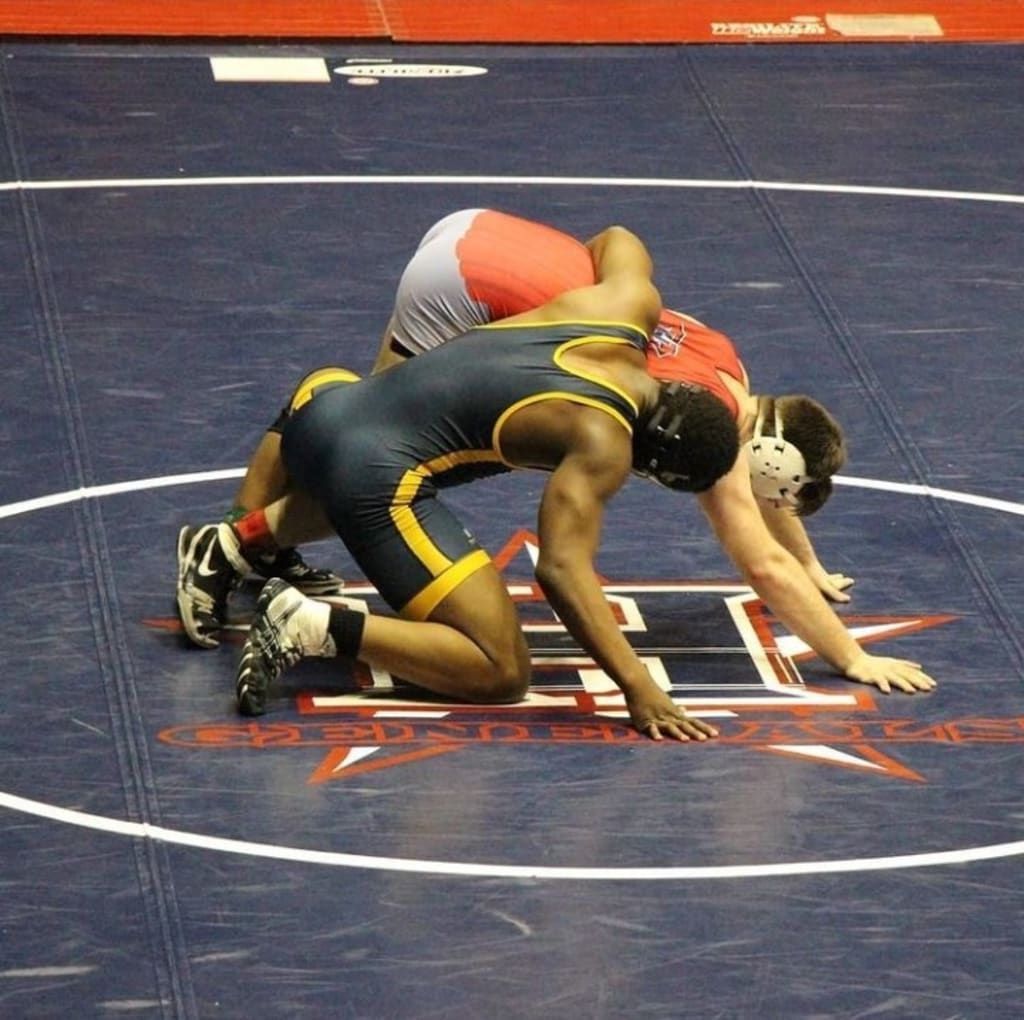A Tale of Two Bodies
A war of two worlds waged in silence

It’s always the same experience. Rightly so, it’s ritual – it’s intentioned to be that way. Always the same silence that toes the line of uncomfortable and meditative. My hands are folded in front of me like in prayer and my mind is similarly inwardly focused. Coaches hang around, silent, sometimes occasionally muttering words of advice and reminders of the absolute necessities for enduring the challenges to come. The man in front of me is the only one whose words I regularly understand. He’s in a similar state to my own – rousing himself from his stupor only to impart words of wisdom and return to his task.
“Left hand at your chin when you let that right hand go late.”
“Keep turning those hips late.”
His hands are practiced. They move quickly – methodically – running tape along my hands and exchanging his tape for sharp scissors when the tape won’t tear cleanly. This doesn’t require thought. It’s second nature to him. Tape, rip, tape, rip, tape, snip, tape. Next, my ankles. The same methodical movements, this time snipping the ends of the tape each time as the tape is thicker and more difficult to tear. Since high school, I’ve done this for myself, supporting my ankles, and protecting myself from injury. When the wrappings are done, when my body is sufficiently protected for what is to come, I stand, slide on gloves, and prepare to fight.
When you hear the words "poetry in motion", what exactly comes to mind? The minds of most people move immediately to a musician elegantly bowing her cello, a gymnast or dancer moving his body with absolute precision, sometimes even athletics – Lionel Messi weaving up and down the pitch. Very rarely does the mind consider the war that occurs in the confines of a ring or mat. Seldom does a person consider the splattered red of blood across a canvas or the bandaged forehead of a man who refuses to surrender any advantage to his opponent. To those people that vehemently deny such an artform – that deny that such an event could ever be an art of any kind – I assert that they have never seen Canelo Alvarez stand in a ring with Daniel Jacobs and refuse to be hit. They’ve never seen Frank Chamizo defend against a takedown. They’ve never seen Saenchai meticulously pick apart his opponent in a ring. They’ve never seen Anthony “Showtime” Pettis channel his creativity in the octagon in a way that can only be described as creating art. That is the art form that I have pursued since I was fourteen years old.
At twelve and thirteen, I was bullied (physically and verbally), severely overweight, and suffering from self-esteem issues – the typical problems of a fat kid in America. In those days, standing up for myself and my beliefs was a rarity, and expecting others to respect my beliefs was an impossibility. Instead, I found myself withdrawing into an exceedingly small circle of friends and generally avoiding confrontational social interactions. I took solace in video games and television – exacerbating my anti-social tendencies to the point of depression.
At fourteen, I entered high school. Every day, I’d see the varsity wrestlers – one national champion, 3 soon-to-be state champions, and many more state placers (second to sixth) – workout every day that I decided to stay after school and pretend to lift weights. They. Were. Massive. Not “Wow, that guy is kind of big,” massive. Not “Oof. I would rather not get into a bar fight with that guy,” massive. They were “What on Earth is that thing that just walked into the room,” massive. Anywhere from 145 to 220 pounds of muscle on each one of them. They pumped out weighted pull-ups more casually than walking across the street and ran sprints on the track for longer distances than I could jog. They were terrifying. Needless to say, with no extenuating circumstances, I would not have had the desire – not to mention the balls – to join the wrestling team. However, when he was in high school, my older brother had once come home beaming with pride, clutching a silver medal, and nursing a black eye. The image of him more excited about the accomplishment than uncomfortable from the pain had always been burned into my memories as something I wanted to experience. So, as my first act as a high school student, I chose to follow in my brother’s footsteps and become a wrestler.
Wrestling is a sport with an ethos that is almost entirely summarized in the words “But I did not quit.” In other words, the only thing that a person wants to do when they begin to compete in the sport is to quit. In the wrestling room, there’s no room for ego. If you’re better than someone you’re drilling with, the guy two feet away from you would smash your face into the mat without batting an eye. To say that the first few months or years of wrestling are humbling is an understatement. You realize how little you know and how hard a human can work to accomplish a goal. You learn more about nutrition, positioning, and body conditioning than you could ever dream of learning. Most importantly, however similar to the way that a musician develops their sound via trial and error or how artists have experimented with different color palettes and artforms to find their niche, a wrestler develops their style.
As a wrestler, you learn that each wrestler has his or her individual style that is a reflection of their personal experiences, their coaching staff, and their body. One wrestler may enter a match and make it a dogfight. Every struggle in their life poured into their war on the mat until their opponent refuses to go on. Violent collar ties wearing on their opponent’s back, hard double leg takedowns that knock the wind out of anyone with a lung in their chest, and a relentless intensity that catches the eye. Conversely, a lankier, calmer soul may show a more complex style that demonstrates his/her knowledge of the sport with every method of attack. A lankier wrestler may elect to defend takedowns in a non-traditional manner, initiating “scrambles” – a non-traditional position intended to make an opponent uncomfortable due to the risky nature of the positions of both wrestlers. Some wrestlers may choose instead to avoid dogfights – instead, wrestling from the outside, slowly picking their opponent apart with strategically chosen attacks and short bursts of explosiveness. Regardless of his chosen style, a wrestler learns that as another wrestler performs on the mat, they communicate their own personality and experiences by infusing them into their style and that those styles – whether they be unconventional or entirely textbook – are dangerous and respectable in their own rights.
By the end of my first year as a wrestler, I had lost roughly 30 pounds and was beginning to win matches. At the end of my second, I had lost ten more and was a varsity wrestler. By my third I had begun to put on muscle, gaining ten and qualifying for state. At the end of my senior year, I was a state runner-up and loved more than anything watching the unspoken conversations that occurred on the mat.
After graduation, I began jiu-jitsu and boxing. There I learned that wrestling was not the only sport where these conversations occurred. In boxing, there’s the “outboxer” – the fighter that prefers to stay outside and pick his shots carefully. There’s the “pressure fighter” the one that relentlessly pressures their opponent until they’ve suffocated in a corner with no space to generate power. There’s the counter-puncher – the fighter that prefers to react to an opponent’s plan of attack. Beyond that, there’s a necessity to meld your style depending on your opponent – to compromise your style in a show of respect for the danger of your opponent’s style. If your opponent is a very dangerous pressure fighter, an outboxer may want to adopt some of the methods of a counterpuncher to force their opponent to respect the distance that the outboxer will want to insist upon throughout the fight.
In fighting, every fight is simultaneously a debate between two artists with their bodies being used as their mouthpieces and an artistic display of two clashing beliefs. One where a fighter insists that their style is better than the other and refuses to surrender until their opponent shows to them – definitively – why they are wrong. And all of this, the absolute beauty of the sport, begins with a pair of scissors and a roll of tape.
About the Creator
Noaria07
Young Writer.
Young King.
Young...Money?
Enjoyed the story? Support the Creator.
Subscribe for free to receive all their stories in your feed. You could also pledge your support or give them a one-off tip, letting them know you appreciate their work.







Comments
There are no comments for this story
Be the first to respond and start the conversation.